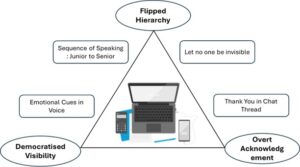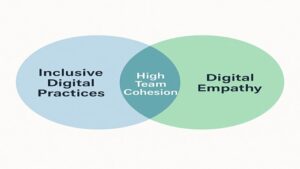Introduction
Leadership has always depended on influence, trust, and human connection. Today, in remote and hybrid workplaces, those connections are filtered through screens and chat threads- reshaping leadership fundamentally. Traditional boardroom charisma is replaced by virtual presence and digital engagement, as conversations migrate to Slack channels and email chains. Leaders face the urgent task of maintaining trust and cohesion even as virtual distance threatens to fragment teams.
The Challenge of Virtual Distance
Virtual distance goes beyond geography- it involves social disconnection, lack of engagement across remote time zones, and emotional gaps due to scarce empathetic interactions. Research shows these factors can reduce trust by as much as 80% in distributed teams when leaders do not adapt. MIT Sloan has found remote employees experience a 37% lower sense of belonging than in-office peers, pointing to a significant challenge for human-centric leadership today.
Inclusion and Empathy: The Antidotes
Evidence supports that leaders who implement inclusive digital practices, such as rotating speaking turns and acknowledging online contributions, directly mitigate the negative impact of virtual distance on team cohesion. When paired with the mindful application of digital empathy- being attentive and validating emotions through digital means- the effect is multiplied. Digital empathy translates the warmth of human connection into the virtual world, infusing remote interactions with authenticity and care.
What Does Digital Empathy Look Like?
- Leaders who consistently acknowledge chat and email contributions, ensuring ideas and efforts are noticed.
- Inviting quieter or more reserved members to participate, not just defaulting to outspoken voices.
- Responding patiently when time zones or technology create delays.
- Reading between the digital lines- responding to signs like an unusually terse email, a muted camera, or periods of silence.
These daily micro-actions add up, signalling ongoing care and inclusion.
Real Evidence for the Model
Microsoft’s Work Trend Index (2022) reports 82% of employees are more motivated when their input is heard during virtual meetings. Gallup’s surveys found employees who feel included are 3.5 times more engaged. Studies from 2021 showed leaders who display virtual empathy improve team trust by 76%, and Harvard Business Review (2023) confirmed that acknowledging digital contributions lifts perceived cohesion by 45%. Where empathy and inclusivity unite, teams register 40% higher cohesion scores than peers led by less empathetic managers.
A Simple Model for Modern Leadership
Breakdown of the core leadership dynamic:
- Independent Variable: Inclusive digital practices (turn-taking, acknowledgment, inclusive prompts)
- Dependent Variable: Team cohesion (measured by trust, belonging, collaboration via surveys)
- Moderator: Digital empathy (responsiveness, validation, and emotional tone)
Inclusivity repairs the cracks caused by distance; empathy cements the team’s bonds.

Practical Steps for Leaders
- Redesign meetings to ensure every member has a voice, not just the loudest or most visible.
- Deploy easy practices: rotate speaking turns, schedule time for quieter members, and train for digital empathy to recognize emotional clues behind terse messages or unusual silence.
- Measure soft metrics- trust, belonging, and engagement, alongside traditional KPIs, as these are crucial for resilience.
- Normalize quick acknowledgments (a simple “thank you!”) with the knowledge that small gestures can dramatically boost morale.
The Future of Leadership
As virtual and global work settings become permanent, digital empathy emerges as a strategic necessity- no longer just a “soft skill.” Leaders must adapt core capabilities like vision and decision-making to the digital realm. The best leaders will not only manage remote teams but cultivate environments where distance is transformed into strength.

Conclusion
Emotional distance is genuine and can erode team performance, but it is not unbeatable. Leadership’s new story is being written- those who embrace digital empathy and inclusive practices build trust, forge strong cohesion, and unlock the best from their people. In today’s workplace, the pressing question is not if digital empathy matters, but whether leaders are ready to practice it consistently.
The story of leadership is being rewritten. Virtual distance is real and damaging but it is not insurmountable. By embracing inclusive digital practices and weaving digital empathy into everyday interactions, leaders can build trust, foster cohesion, and unlock the full potential of their teams. In the hybrid era, leadership is no longer defined by presence in a boardroom, but by presence in every digital interaction. Those who practice empathy consistently will not only strengthen trust and cohesion, but unlock resilience and innovation in their people.
In today’s workplace, empathy is no longer a soft skill- it is the hardest, most strategic skill a leader can master.
The question, then, is not whether digital empathy matters. The real question is: are today’s leaders ready to practice it consistently?




